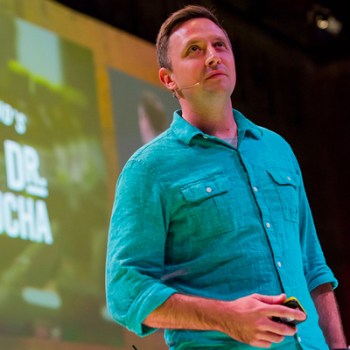
Kombucha: It’s not coffee, it’s not broth, but if you’ve had it before, you may remember a pungent aroma of vinegar or recall the whisperings of granola hippies at Whole Foods Market boasting its probiotic superpowers. You can even make Kombucha yourself.
But what is the stuff and why, with espresso and beer on tap, would anyone drink it?
Matt Thomas, founder of Brew Dr. Kombucha and Townshend’s Tea Company, gives The Manual a lesson on Kombucha 101 (which ended in a Costco run for a family-sized pack of 30 bottles and us swapping out our evening beer for a can of the ‘bucha every other night.)
What Is Kombucha
“Kombucha is another word for fermented tea,” says Thomas. “The name comes from Japan when a doctor named Kombu or Kambu treated the Emperor Inyko with the tea. Cha’ means tea. ‘Kombu’ and ‘Cha.'”

The process of making kombucha is quite simple. In fact, Thomas suggests trying your own batches at home. This is what one of his employees at Townshend’s Tea Company in Portland, Oregon, was doing in 2008. After hearing the patrons of the tea house buzzing about this new beverage, kombucha, Thomas asked his employee to bring in a batch. They started making a jar in the kitchen and one jar turned into two, then four, and eventually the operation took up the entire back room until Thomas moved it to the basement, brewing 400 five-gallon buckets at a time.
How to Make Kombucha
Seeing as all kombucha starts its life as tea, Thomas had a leg-up on the other few competitors in the category since he and his team at Townshend already formulated great, 100-percent organic, non-GMO teas.
The process of making kombucha is quite simple. In fact, Thomas suggests trying your own batches at home.
After the tea steeps, it’s fermented with the help of a symbiotic culture of bacteria and yeast (SCOBY, for short). Brew Dr. ferments its kombucha for a month, during which time the PH drops and the sugar gets consumed by the yeast. This is also when all the healthy cultures and organic acids form.
“It also produces alcohol,” says Thomas. “Anytime you feed yeast sugar, it will produce alcohol.”
During fermentation, the pungent vinegar aroma emerges — the reason Thomas had to move Brew Dr.’s fermentation out of the teahouse basement. (Brewing in large enough batches, your clothes will reek of vinegar.) After fermentation, the alcohol needs to be removed.
Brew Dr. wants to be transparent about their method of making kombucha to help get rid of Frankenstein kombuchas.
Thomas remembers a massive recall that occurred at Whole Foods Market during the start of the kombucha craze (before Brew Dr. got its name into the Amazon-owned health food store). The issue (for Whole Foods, at least) was that the kombucha had too much booze in it. This dilemma prompted Thomas to research both inside and outside the industry on innovative ways to solve the problem responsibly while keeping the kombucha authentic. The result was the purchase of an expensive, non-heat distillation machine (SCC – Spinning Cone Column), which was also being used by the wine industry. Processing kombucha in this way removes the alcohol without harming the live and active cultures.
This machine enacts a process that also removes the caffeine from the tea, making a alcohol-less kombucha the equivalent to decaf coffee.
(Fun fact: The alcohol extract of Brew Dr. Kombucha is made into Townshend’s tea spirits.)
What Does Kombucha Taste Like?
Brew Dr. steeps 10 different teas (plus one seasonal flavor), ferments, then distills (to remove excess alcohol while keeping all the natural probiotic power), but other brands go a different route. Some use the same tea base for all their flavors, adding various sugary juices after the fermentation process for taste.

Other big brands add sparkling water to a micro amount of pasteurized kombucha cultures (no, kombucha should not be pasteurized as you’ll lose all the active cultures and organic acids that create good gut health) in order to keep alcohol levels down on the cheap. Those same companies then add probiotics in at the end.
“Kombucha sold as a healthy beverage,” according to Thomas, “should fill two requirements: It should be made from a fermented tea that fits the traditional way kombucha has been made for millennia and be truly non-alcoholic so it can be safely given to children and anyone avoiding alcohol.”
Brew Dr. wants to be transparent about their method of making kombucha to help get rid of Frankenstein kombuchas. That’s because when done correctly the fermented tea tastes great and is damn good for you.
What are the Health Benefits of Kombucha?
“Kombucha is a low-sugar and low-cal replacement for soda and beer because it creates this dynamic mix of live and active cultures and organic acids,” says Thomas. “That’s why people started drinking kombucha. It really is impactful. Fermented food used to be part of the human diet for centuries. There were no other means of food preservation apart from drying out or fermenting. Now that there’s refrigeration, naturopaths are prescribing kombucha for gut, stomach, or liver health and to adds balance back into the body’s internal ecosystem.”

The kombuchas made with tons of juice, aka fructose? Not as good for you. And the kombuchas that aren’t fermented to develop the cultures and acids? You guessed it. Also not as good for you.
Thomas drinks the equivalent of three cans a day and has dodged every stomach bug his three boys have brought home from school. He also has buddies that swapped out their soda addictions for Brew Dr. and dropped a ton of weight and felt lightyears better after a few months. On lunches where Thomas and his friends have the urge to pair the meal with a beer, they order a kombucha, which mirrors the carbonation and fermented flavor of a brewski.
For those looking to get into the great outdoors, Brew Dr. is releasing kombucha cans nationwide so you don’t have to worry about glass bottles breaking during a hike or on-the-go.






